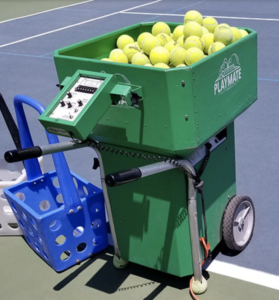Tennis ball machines use different mechanical methods to throw balls, and they come with different features designed to add different spins, variety, realism and convenience to a practice session. Understanding some basic facts about tennis ball machines can help you improve your game against a live opponent.
Two Types of Throwing Methods
Ball machines send balls either using air compression or rotating wheels. In compressed-air machines, ball are fed from a holding area into a pneumatic tube, blocking the air. When the air pressure builds to a strong enough point, the ball is forced out of the tube toward the player. Machines with rotating wheels feed balls between two wheels that squeeze the ball between them, making them shoot toward the player.
Ball Spins on Tennis Machines
Both types of ball machines put spin on a tennis ball to add variety and realism to practices. Pneumatic tube machines use a an adapter inside the tube against which one side of the ball brushes, creating either a backward spin (to simulate slice) or a forward spin (to simulate topspin).
In rotating wheel ball machines, the wheels are set one on top of the other (instead of side by side), with one wheel spinning faster than the other to create slice or topspin.
Tennis Ball Wear & Tear
Because the ball is compressed against the hard rubber wheels in rotating wheel ball machines, balls wear out faster when used in this type of machine instead of a pneumatic tube machine.
Some are Tennis Ball Machines Programmable
The more expensive ball machines can be programmed to vary ball placement, spin, depth, trajectory and speed. Some machines have a panel built into or hung on the side into which ball projection patterns are programmed.
Others have wireless remotes that allow the player to turn the machine on and off from the opposite side of the net. This helps players avoid having to run across the court after the machine is started while several balls are shot to no effect, or it lets coaches stop and start lessons and drills.
Ball Machine Warranties
When shopping for a ball machine, check the warranty carefully to learn more facts about tennis ball machines that can help you make the right choice. Some can’t be fixed locally and you might have to pay shipping costs to get a ball machine fixed, even if it’s under warranty. Some manufacturers replace parts, but you have to find someone to exchange the parts, or pay the manufacturer to do it.
Make sure the motor is covered, in addition to the other parts of the machine. Check online buying sites like Amazon to read ball machine reviews by customers who have purchased a machine and used it for more than a few weeks.
WARNING: One of the little-known facts about tennis ball machines is that the way most people use them, tennis ball machines can cause more damage to your strokes than. Read our article on properly using ball machines to avoid hampering your game.
